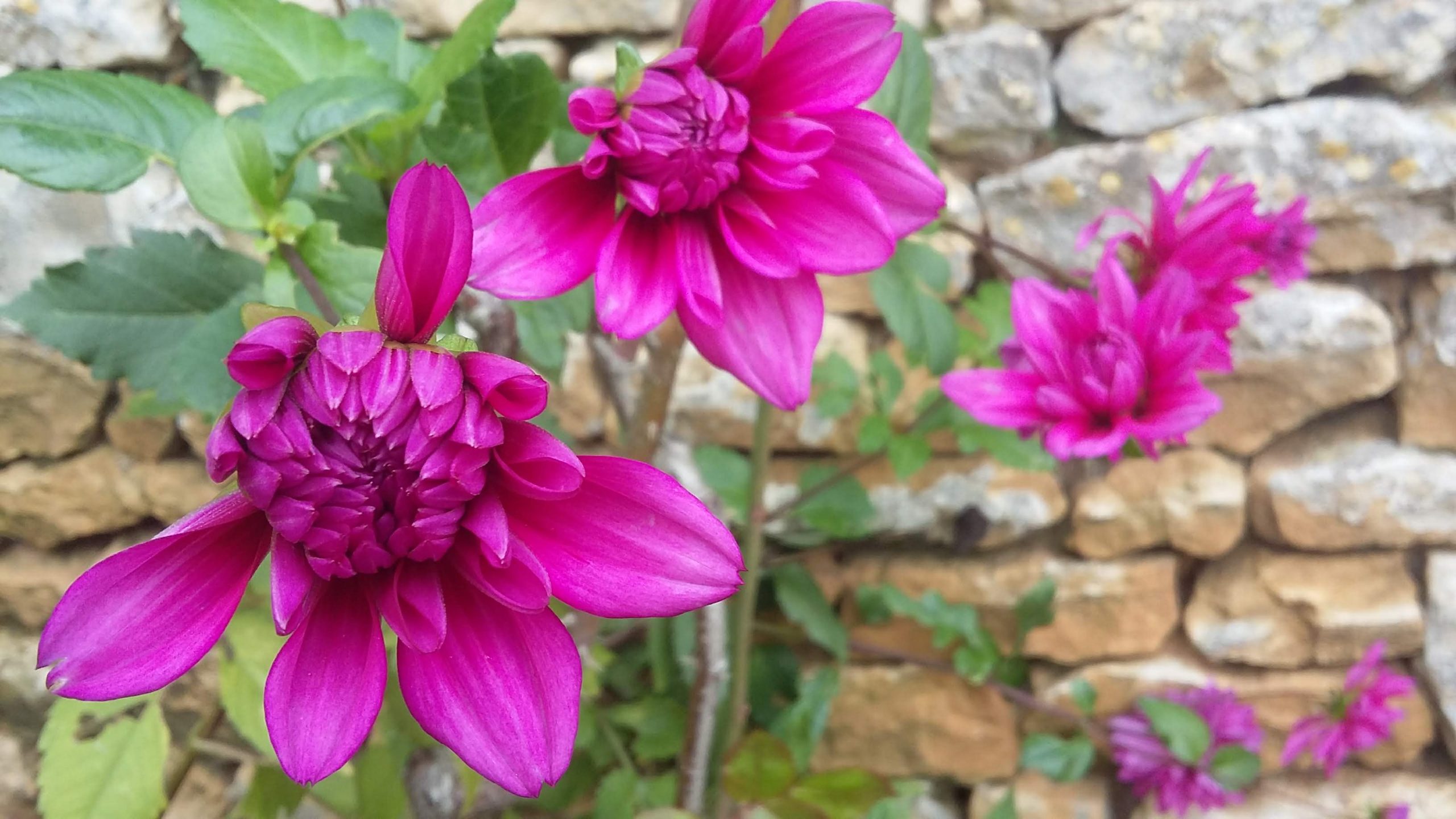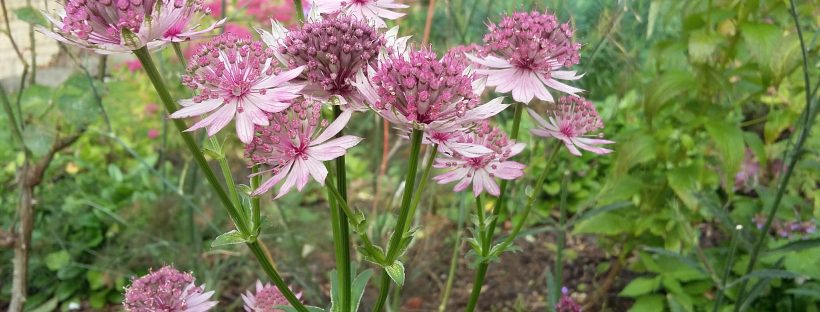C’est la rentrée! The mornings now have a distinct freshness about them, which can be a relief from the baking heat of midsummer, but it is a sign that the season is about to turn later this month. La Chasse resumes (sadly), the sweetcorn and sunflower fields will soon be cut and swallows will start gathering once again later this month in preparation for their annual marathon back to Africa. Nights draw in, but this is nothing to lament and heralds the return of warm nights snuggled by the fire after enjoying a hearty meal generously filled with your own garden produce. The garden may appear to be slowing down too, but don’t take your foot off the gardening pedal just yet! Here is your September Garden To Do List:
Lawns
The seasonal rains may return by the end of this month and the lawn, which by now is usually nothing but scorched earth and thatch, will return.
Treat the lawn to a cut, which will help trim off any weed seedheads and encourage the recovering grass to thicken up once again.
Once the lawn has started regrowing strongly again scarify the lawn, either with a spring tine rake or a machine, to get rid of all the summer’s dead thatch. Add the thatch to the compost heap.
Overseed with your choice of grass seed to quickly fill any gaps in the lawn and prevent weeds from taking up residence in the gaps when germination begins with the return of the seasonal rains. The action of scarifying should have broken the surface of the soil sufficiently for the seed to get some purchase and more easily take root. Simply sow your seed and lightly walk across the area to push the seed into the broken soil surface to ensure there is good contact between the two. Water the area with a fine rose or spray setting to avoid dispersing seed and causing them to ‘pool’ together. I like to add a little fine compost after sowing and watering just to help retain the moisture and discourage birds from pinching it all. If the seasonal rains haven’t yet returned, keep moist over the next couple of weeks and the seed should germinate easily.
For environmental reasons I do not apply fertilisers to my own lawns, or those of my clients, but if you feel you must fertilise, ensure at least you are using an organic fertiliser. At the time of year use an autumn formula version. Autumn formulas have a lower nitrogen content, but are richer in phosphates and potassium to encourage stronger cell growth and roots for better winter hardiness. Deeper rooting will help the lawn the following summer too.
If the perfect lawn really is your thing apply a selective lawn weedkiller. Be careful to use it sparingly and treat only the areas that need it to keep your impact on the environment to a minimum.
Box hedges
Remember to inspect your box hedges for box tree moth caterpillars. If you identify its caterpillars are present the preferred option is to remove them by hand and dispose of them. For small topiaries etc this is practical. For large hedges treat with Bacillus thuringiensis (a natural soil-borne bacteria) to kill the box moth caterpillars. Apply the treatment in the early morning to prevent it from evaporating before it can take effect. Use only when box tree moth caterpillars are present to target this species only and ensure minimal destruction of other insects.
Use in conjunction with a pheramone trap to really interrupt the lifecycle of the box tree moth and maximise efficacy.
Collect seed

Collect seed from any summer annual and biennial flowering plants you wish to make more of, such as Daucus carota, or Dipsacus fullonum. Sow them whilst still fresh this autumn so that they may germinate in the still warm soil ready to take off again next spring.
Sow direct to the soil, or (either to improve your chances or dictate planting positions) use toilet rolls to sow the seed into and over winter before planting out in spring: these are not only an environmentally friendly alternative to plastic, but they will accomodate the long tap roots of such plants, which will resent being disturbed when planted out into the garden in spring.
Meadows
Cut down the meadow this month while it is still dry. Cutting a wet meadow is a real pain. Use a strimmer with a thick cord to minimise messing around with cord breakages. Cut the grass short and dont worry if you accidentally scalp any areas: this is perfect for giving the wildflowers the space they need to move in.
Leave the cuttings in situ for a week or so to allow seed to disperse. Then rake away all the cuttings to keep fertility in the meadow low. Fertility is the enemy of a successful meadow so don’t allow the plant material to decompose where it falls. This will only enrich the soil and encourage the grasses to grow more strongly at the expense of your other flowering plants.
After clearing the area of cut grass and flowers, rake or scarify the grass and other plant material vigorously to expose soil between the grass blades into which the seed can germinate and take root. Walk over the area to ensure the seeds are in good contact with the soil, just like you would for lawn preparation. Then leave it alone and let nature take its course. You may not see any germination until March next year: some wildflowers won’t burst into life straight away and until the winter cold has passed.
For those who prefer a little more control over where the wildflower seed is going, prior to cutting the meadow down, collect the seed and then manually sow after cutting and raking.
If you want to dramatically increase your stock of wildflowers, or introduce some new ones, buy some additional seed now and sow and tread in as above.
Deadheading

Continue deadheading flowers such as Penstemons, Roses, Dahlias and Buddleia. Remember to prune back to just above a leaf joint (‘node’) for better aesthetics, plant health and to encourage flowering side shoots.
Prune hedges
Unless you have already cut your hedges this summer, in which case shame on you, September is the month we can whip our hedges back in to shape.
Late summer pruning will restrict hedge regrowth and keep them looking crisp in winter. This late summer response to pruning is useful for keeping established hedges in shape over winter. Similarly, if you need to renovate a hedge that has gotten out of hand (such as rampant Prunus laurocerasus) this late summer response to pruning will minimise the hedge’s response to ‘bounce back’ even more strongly, which it will do if given this treatment in early spring. The birds ought to have finished nesting by now, but it is worthwhile checking hedges just in case, especially since climate change does seem to be interfering with nesting patterns. If the hedge does contain an active nest, it may be best to leave this activity until the start of October.
Order bulbs
If you haven’t already done so, order your winter and spring flowering bulbs now so that you can get them in the ground in the next month or two (Tulips should not be planted until November).
Consider your replacements
With weather in July and August regularly hitting the high thirties, and in some years often peaking above 40 degrees, you may find that one or two plants have sadly not made it. Now is the best time of year for new planting so order replacements. Consider first, however, why your plant may have failed and take this into account when ordering and planting. Was it in the wrong place? Was the plant not of a type that is sufficiently drought tolerant? Was it planted in the spring and just hadn’t established sufficiently to survive without regular watering? Does the soil need some improvement, or had you failed to mulch in May? Questions such as these will help guide your decision making to try to avoid a repeat failure next year.
Wisteria
Continue lightly pruning any wayward or unruly whippy growth for now back to about 5 leaves or so. The ‘proper’ prune will come in December once the leaves have dropped.
In the potager
Continue harvesting and enjoy the fruits of your labours. Autumn raspberries and blackberries are ripe. Beans, tomatoes and peppers are still on the go. Squashes, pumpkins and the like will be ready this month too.
You can tidy soft fruit that is now finished, such as summer fruiting raspberries. Remove the mature brown canes leaving the green canes that will supply next summer’s fruit. Tie in the new canes just to keep it organised, and safe from winter damage.
You may also find that your top fruit is ready for harvest this month. When you start to see apples and pears dropping from the tree this is usually a sign things are ready. Apples and pears should come away in the hand quite easily if they are ripe. If they don’t, leave them until they are.
Plant of the month

Dahlias might be a somewhat obvious choice for this time of year, but they are a late summer classic with many reasons to love them, not least that they are fairly low maintenance, don’t require any irrigation or other help from you once they are established and keep flowering right through the autumn until they are taken out by the first frosts. The choice of flower shapes and colours is almost endless. Dahlia ‘Café au Lait’ is a blousy yet chic choice, with exceptionally large flowerheads. For a hit of summer heat try D. ‘Honka Red’. For something a little more naturalistic consider species Dahlia, D. australis.
Just plant them in spring somewhere you can get to them easily for regular deadheading.
I don’t fertilise my plants just to keep them a little more on the compact side, which reduces the need for any staking. This seems to help with pest control and doesn’t seem to discourage strong repeat flowering, in my garden at least.
Early in the year new growth is vulnerable to snail and slug attack. A nature-centric method of pest control is best so encourage birds, hedgehogs, frogs and toads into the garden and these will keep slugs and snails from decimating them.
Conventional advice is to lift the tubers from the ground once the frosts have taken out the foliage and store them for winter. They can rot if the tubers do get too wet over winter, but I have numerous dahlias here, I just leave them alone do to their thing and they return every year just fine without our interference. A true high impact, low input plant.

No responses yet